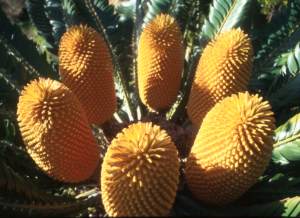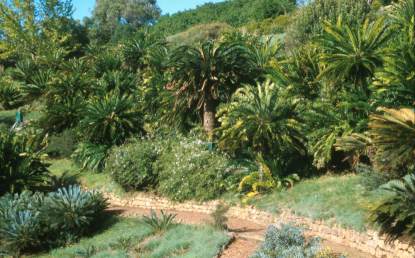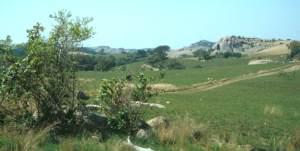Encephalartos woodii
Encephalartos woodii Sander
Family: Zamiaceae
Common names: Wood's Cycad (Eng.); Wood-se-broodboom (Afr.)
SA Tree No: 14
Introduction
Encephalartos woodii is famous for being extinct in nature, and for the fact that there is no known female specimen on Earth.

Description
Description
Encephalartos woodii is a very handsome plant. The leaves are a dark glossy green, 2 to 3 m long, with a gracefully arching shape, giving this cycad a dense umbrella-shaped crown, even in young specimens. The Kirstenbosch specimen is unbranched, but mature specimens are often branched at the crown. Encephalartos woodii reaches majestic proportions, up to 6 m in height with a trunk diameter of up to 900 mm at the base, 600 mm nearer the crown. The 100+ year-old specimens at Durban Botanic Gardens trunk circumference exceeds 2 m and has an estimated mass of 2.5 tons. A characteristic that is unique to Encephalartos woodii is that in mature specimens the trunk broadens towards the base, forming a kind of buttress in order to support the weight of the trunk. Furthermore, towards the base of the trunk the leaf bases are so compressed by the weight it supports that the trunk is unusually smooth. At Kirstenbosch the base of the trunk is obscured by a cage that surrounds plant, put there in the 1980s to prevent suckers from being stolen again.

Encephalartos woodii produces six to eight bright orange-yellow cones. These are large, cylindrical in shape, 400-900 mm long, occasionally reaching a length of 1.2 m, with a diameter of 150-200 mm. Cones are formed on the Kirstenbosch specimen every 2-3 years, and the pollen has been used to create hybrids with a number of species in our collection.
Encephalartos woodii is very well represented in botanic gardens and cycad collections throughout the world. Possibly as many as 500 specimens exist, all of them derived from basal suckers or offsets from the original plants discovered by John Medley Wood. The Kirstenbosch specimen was acquired in 1916, also a sucker from one of the Durban Botanic Garden plants, sent to us by James Wylie.
Encephalartos woodii is considered to be most closely related to Encephalartos natalensis. Some authorities regard it as a relic from a species now extinct, others as a mutation within Encephalartos natalensis or a robust form of this species. Still others regard it as a natural hybrid between Encephalartos natalensis and Encephalartos ferox.

Conservation Status
Status
Extinct in the Wild (EW)
Legislation affecting Encephalartos woodii
Encephalartos woodii is protected by both national and international legislation:
On a NATIONAL level, this legislation differs from province to province and is policed by the Nature Conservation authority. In the Western Cape (and probably the Eastern and Northern Cape who were all part of the same province in 1974 when the ordinance was passed) Encephalartos woodii and all other species and hybrids, are listed on Schedule 3 (Endangered Flora) and one requires a permit from Nature Conservation to move, sell, buy, donate, receive, cultivate and sell Endangered Flora and to own adult cycads. When buying endangered flora, make sure that the seller is registered with Nature Conservation and that they issue an Invoice. For more information, please see www.capenature.co.za, or contact your provincial nature conservation authority.
On an INTERNATIONAL level all species and hybrids of Encephalartos are on Appendix I of CITES, the Convention on International Trade in Endangered Species of Wild Fauna and Flora. This means that wild collected material may not be traded and for each and every artificially cultivated Encephalartos plant or piece of a plant or a cone or pollen or seed, being carried over an international border requires a CITES Export Permit issued by the authority of the exporting country, and a CITES Import Permit issued by the authority of the importing country. Buyers are advised to make sure that the seller is a reputable, registered dealer and that an invoice is issued with the sale. For more info on CITES, please visit their website: www.cites.org - they give a great deal of info. including a list of national authorities of all member countries, or speak to your local authority.
Finally, please note that the above legislation has nothing whatsoever to do with plant health and cleanliness legislation, which is applicable to the import/export of all plant material and which is usually under the jurisdiction of the Dept./Ministry of Agriculture.
Distribution and habitat
Distribution description
Only one clump of male plants has ever been found. John Medley Wood found this clump of four plants in 1895 on a steep south-facing slope on the fringes of the Ngoye Forest about 30 km from Mtunzini in KwaZulu-Natal.
Derivation of name and historical aspects
History
The name Encephalartos is derived from the Greek en meaning 'within', kephali meaning 'head', and artos meaning 'bread'. This species is named after John Medley Wood (1827-1915) who found the last remaining clump of four plants in 1895 in the Ngoye Forest in KwaZulu-Natal. These are the only Encephalartos woodii plants ever found and all of them are male plants originating from one plant. Medley Wood was a merchant sailor, farmer, trader, sportsman and botanist. He founded the Natal Herbarium and was Curator of the Durban Botanic Gardens. In 1903, Wood sent his deputy James Wylie to fetch some of the smaller offsets and three of them were grown in the Durban Botanic Gardens. In a 1907 expedition, Wylie collected two of the larger trunks, both of which are still to be seen on the Old Conservatory terrace in Durban Botanic Gardens. In 1907 Wylie noted that the largest of the four trunks was badly mutilated did not expect it to survive. He was right, by 1912 there was only one 3m tall trunk left in the wild, and in 1916, the Forestry Department, concerned about the survival of the remaining stem, arranged to have it removed and sent to the Government Botanist in Pretoria. It is thought that this trunk subsequently died in 1964.

Despite numerous excursions in the Ngoye-Mtunzini area, no other specimens of Encephalartos woodii have ever been found. However, this area has not been completely and systematically surveyed so there is still hope that there is another specimen lurking in the depths of the forest.
Ecology
Ecology
The young leaves of all species of Encephalartos are grazed by sheep, buck, dassies and baboons. Encephalartos seeds, however, are extremely toxic, not the fleshy pulp that is eaten by birds, baboons, monkeys, rodents and bats, but the hardcoated kernel.
Uses
Use
Thunberg and other early travellers recorded that the local people used cycad trunks as a source of food. They removed the starchy pith, tied it in an animal skin, fermented it and then ground it into a meal.
Growing Encephalartos woodii
Grow
Encephalartos woodii is possibly the most sought-after cycad in the world. It is fortunate that it is the fastest growing species of Encephalartos and one of the most vigorous in cultivation. It produces numerous suckers, and new leaves are formed every year. For optimum growth, Encephalartos woodii requires fertile well-drained soil and ample water. It can withstand relatively long dry spells, but plants that receive regular water are healthier and have larger leaves. During summer give sufficient water to soak the root area once a week. Watering can be suspended during winter. Remember that good drainage is crucial. In hot dry regions inland, the sun tends to burn the leaves and they are better planted in light shade. A mulch of well-rotted compost applied at least once a year around the base of the plant, plus application of a balanced fertiliser twice a year during summer (1 kg to each mature plant), will keep the plant in good condition and maintain growth.
Encephalartos woodii makes a good container plant when small, but will have to be planted out when it becomes too large. All our cycads make ideal outdoor container plants, but remember to position them where the sharp leaf spines will not do damage to passing human traffic. Use a well-drained soil mix, e.g. 6 parts coarse sand : 8 parts milled bark : 6 parts friable loam. Add dolomitic lime, iron sulphate and a slow release inorganic fertiliser. Encephalartos woodii, being fast-growing, will quickly fill the container up with its roots and, if not repotted, may burst the pot with its expanding roots. Cycads in containers require watering every other day during summer, particularly during hot and windy weather, and must never be allowed to dry out completely. It is important that the growing medium be kept moist, but the excess water must be allowed to drain away to prevent rotting.
Propagation is by offsets and suckers. Encephalartos woodii does not go completely dormant, but growth does slow down during winter. Suckers are best removed in early spring, with a clean sharp spade or a knife. They should be larger than 100 mm in diameter; the larger the sucker the better its chance of survival away from its parent. Treat all cut surfaces, on the parent and the sucker, with flowers of sulphur to prevent fungal infection. Store the sucker in a cool dry place for about three weeks to allow the wound to seal. Before planting, dust the wound with a rooting hormone to stimulate the development of roots. Keep moist and in light shade until it produces new leaves, whereafter a weekly feed with a balanced liquid fertiliser during summer is recommended.
There being no female plant, seed is out of the question, but there are a few projects underway to remedy the situation. There is still the hope that a female plant is in the Ngoye forest somewhere and expeditions in that area always keep a look out for one. The most promising project is the crossing of Encephalartos woodii with its closest relative Encephalartos natalensis, and crossing the offspring with Encephalartos woodii again with the result that each successive generation is more and more Encephalartos woodii. There is also the remote possibility that a spontaneous sex change will occur in one of the male plants. Sex reversal has been observed in a few cases involving other species and once the process is more fully understood, it could be induced in an Encephalartos woodii plant.
References
- Giddy, Cynthia.,1984, Cycads of South Africa, Second Revised Edition, C.Struik Publishers, Cape Town
- Osborne, Roy et al., 1993, The Cycad Collection, Durban Botanic Gardens, Parks Dept., City of Durban
- Osborne, Roy, 1986, Encephalartos woodii, Encephalartos (5): 4-10
- Donaldson, John & Winter, John, 1998, Grow Cycads, Kirstenbosch Gardening Series, NBI, Cape Town.
Credits
Alice Notten
Kirstenbosch National Botanical Garden
May 2002
Plant Attributes:
Plant Type: Tree
SA Distribution: KwaZulu-Natal
Soil type: Sandy, Loam
Flowering season:
PH: Acid, Neutral
Flower colour:
Aspect: Full Sun, Morning Sun (Semi Shade), Afternoon Sun (Semi Shade)
Gardening skill: Easy
Special Features:
Horticultural zones









Rate this article
Article well written and informative
Rate this plant
Is this an interesting plant?
Login to add your Comment
Back to topNot registered yet? Click here to register.